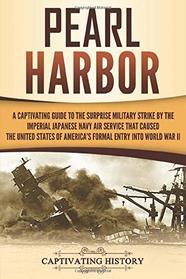When looking at this book, I thought I knew the whole story of Pearl Harbor and the aftermath. Boy, I was wrong. Every few pages I was accosted by another surprising part of our history.
One was the mock attack by Rear Admiral Harry Yarnell, one of the few naval commanders who was also an aviator. He was the commander of the mock attack force in February 1932 and he struck early in the am with airplanes, not battleships. The defending group was expecting a naval attack and were totally unprepared for Yarnell's attack. None of the defending airplanes got off the ground before they were taken out of commission and Yarnell was declared the winner. The US press distributed the story of the mock attack and the Japanese naval officers read it with interest. A few years later, the Japanese would use much of Yarnell's plan in their preemptive strike on the United States. The surprise attack caused the US, who were trying to stay out of the conflict, to immediately arm for battle.
Another surprise was V-mail. To reduce the cost of transferring an original letter through the military postal system, a V-mail letter would be censored, copied to film, and printed back to paper upon arrival at its destination.
The extensiveness of the Japanese Internment Camps in America was another surprise. It was shocking to see that they and Germans were not trusted by the citizens or government. However, based on the stories from my husband's family, many people (of many ethnic groups) were afraid that their US patriotism would be suspect during the dark days of WWII.
Not being a war-aficionado, I didn't realize that Italy had changed sides after the Italians got rid of Mussolini during the second WW. Another surprise was the use of German paratroopers speaking American English behind enemy lines, who spread misinformation and changed road signs.
The transfer of power, upon Roosevelt's death, was another surprise. Eleanor Roosevelt told Harry Truman about her husband's death. One has to feel sorry for Truman; he was vice-president only 3 months and Roosevelt kept his VP in the dark about many things.
Until reading this book, I had no idea that the Australia mainland had been attacked during the war. New Zealand and Australia defended their homeland while sending soldiers to fight on the European front.
One of this book's strong points is the time spent explaining the pressures on Japan, China, Korea, and the other nations, that made them act in the way they did leading up to and during the war. It made sense of the varying pressures on governments and how they addressed those issues. This book is well worth a reader's time
One was the mock attack by Rear Admiral Harry Yarnell, one of the few naval commanders who was also an aviator. He was the commander of the mock attack force in February 1932 and he struck early in the am with airplanes, not battleships. The defending group was expecting a naval attack and were totally unprepared for Yarnell's attack. None of the defending airplanes got off the ground before they were taken out of commission and Yarnell was declared the winner. The US press distributed the story of the mock attack and the Japanese naval officers read it with interest. A few years later, the Japanese would use much of Yarnell's plan in their preemptive strike on the United States. The surprise attack caused the US, who were trying to stay out of the conflict, to immediately arm for battle.
Another surprise was V-mail. To reduce the cost of transferring an original letter through the military postal system, a V-mail letter would be censored, copied to film, and printed back to paper upon arrival at its destination.
The extensiveness of the Japanese Internment Camps in America was another surprise. It was shocking to see that they and Germans were not trusted by the citizens or government. However, based on the stories from my husband's family, many people (of many ethnic groups) were afraid that their US patriotism would be suspect during the dark days of WWII.
Not being a war-aficionado, I didn't realize that Italy had changed sides after the Italians got rid of Mussolini during the second WW. Another surprise was the use of German paratroopers speaking American English behind enemy lines, who spread misinformation and changed road signs.
The transfer of power, upon Roosevelt's death, was another surprise. Eleanor Roosevelt told Harry Truman about her husband's death. One has to feel sorry for Truman; he was vice-president only 3 months and Roosevelt kept his VP in the dark about many things.
Until reading this book, I had no idea that the Australia mainland had been attacked during the war. New Zealand and Australia defended their homeland while sending soldiers to fight on the European front.
One of this book's strong points is the time spent explaining the pressures on Japan, China, Korea, and the other nations, that made them act in the way they did leading up to and during the war. It made sense of the varying pressures on governments and how they addressed those issues. This book is well worth a reader's time




